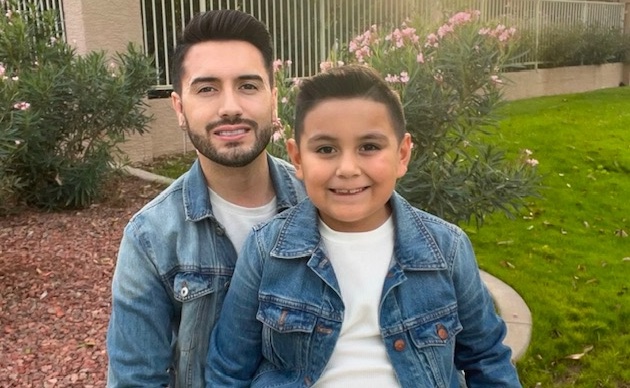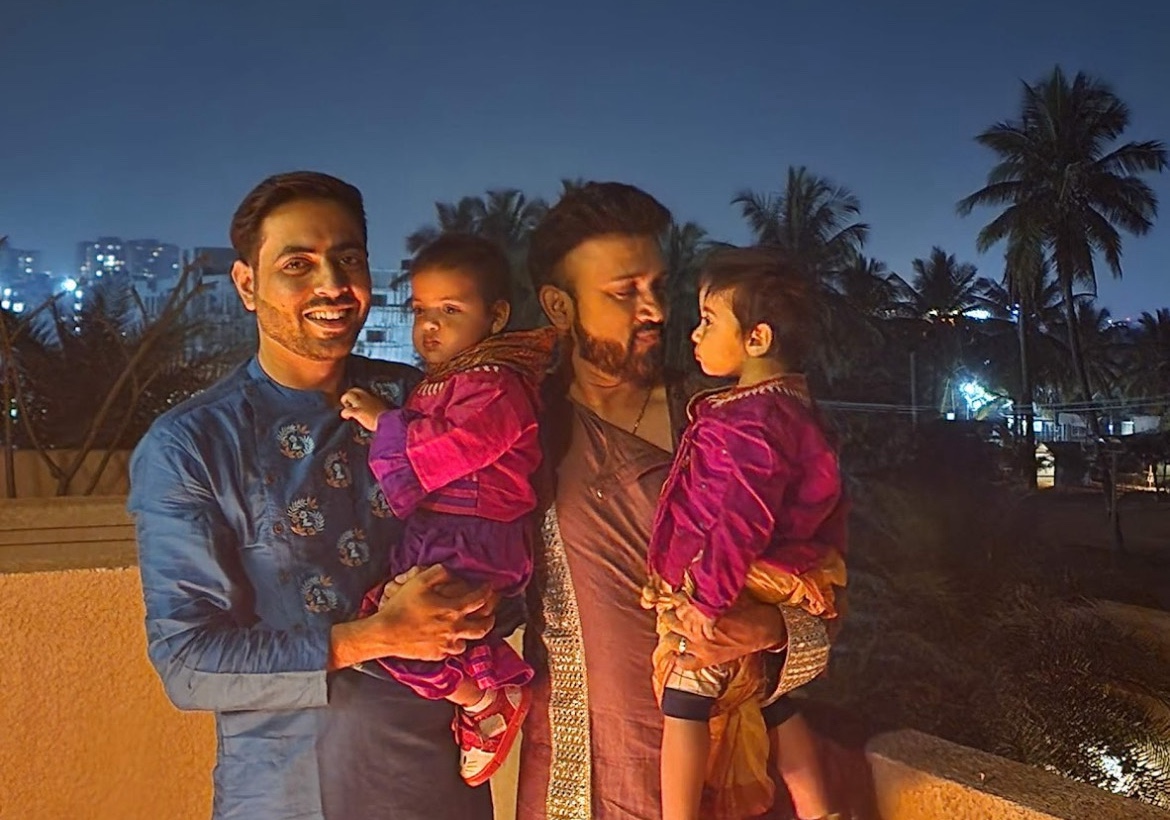Well-coiffed hair? Check.
Color-coordinated school supplies? Check.
New Paw Patrol sneakers? Took some serious convincing … Check.
Feeling welcomed at Max’s new school?
The first day at a brand-new school is a little different for children with two dads. And I don’t just mean because they’re dressed better. Not to sound all victim-y, but we just have some additional things to worry about. But before I get into all that … let’s go back a few months.
When my husband Alex and I toured our local public school, we asked if there were any other same-sex parents at the school. No, we weren’t looking to spice things up, we honestly just wanted to get a temperature check on the topic. We were told that the school was very inclusive and that they embraced family diversity. We liked what we heard and saw and in the end we decided the school would be a good fit for our family.
Our son Max would be attending transitional Kindergarten — the first year of a two-year kindergarten program for students whose fifth birthday falls between September and December. In the days leading up to the first day of school, Alex and I started worrying about how having two dads might impact his experience.
Would his teacher know how to serve a child who’s growing up in an LGBT-headed family? Will the school provide opportunities for my child to see his family reflected in the curriculum? Would Max feel comfortable being open about his two dads? As we see it, a 4-year old child shouldn’t have to bear the burden of the struggle for LGBT rights and diversity in his school. That’s the job of parents, and in an ideal world, the school administration.
So naturally, going into it we felt like we had more to prove to his teachers, his peers and their straight parents. We attended all the “meet the new family” events that the PTA had organized because we wanted to take every opportunity to ingratiate ourselves to the other families. You know, to show how “normal” we are.
 As his first day of school approached, we held our collective breath waiting to see how the school would react to us. And I’m happy to say that so far, so good. Max loves going to school. And we love sending him. The teachers are warm and attentive. The parents are young, diversified and seemingly progressive. They’re more concerned about raising money for fieldtrips than the fact that Max has two dads — which means they clearly have their priorities in order. But that doesn’t mean there haven’t been some uncomfortable moments along the way that make us keenly aware of our differences.
As his first day of school approached, we held our collective breath waiting to see how the school would react to us. And I’m happy to say that so far, so good. Max loves going to school. And we love sending him. The teachers are warm and attentive. The parents are young, diversified and seemingly progressive. They’re more concerned about raising money for fieldtrips than the fact that Max has two dads — which means they clearly have their priorities in order. But that doesn’t mean there haven’t been some uncomfortable moments along the way that make us keenly aware of our differences.
Let me be clear — we’ve experienced no discrimination whatsoever. But is that enough? Should we be satisfied with not being discriminated against? Should we accept that or should we aspire for more? It’s like when people throw out the word “tolerant” — I don’t want to be tolerated. I want to be embraced and accepted like everyone else. The door between LGBT parents and public schools has started opening, but I’m wondering if now’s the time to push it open all the way.
On the first day of school there was a special assembly to welcome all the new students and their parents. We looked around and noticed that no two kids looked the same. It was a beautiful melting pot of colors, cultures and nationalities. We got to meet other parents and chat with teachers. At the end of the assembly the principal read a book entitled “The Kissing Hand” about a raccoon that doesn’t want to go to school. The raccoon’s mother ends up convincing him to go by reminding him about all the fun things that’ll happen at school and by kissing his hand, implying that she’ll be with him in spirit.
Like in most children’s books, the word “mother” was used countless times throughout the story. But the repeated use of the reassuring phrase “mama loves you, mama loves you” was the part that made me concerned for Max. As if those words are the only words that could allay a child’s fears. Was Max wondering where’s the mama that loves him? There was nothing in this particular story that represented his family. And to a broader sense, nothing that mentioned fathers in general. Educators have the responsibility to help LGBT-headed families feel welcome and included in the school community. So you’d think they’d make more of an effort to incorporate more inclusive stories into their curriculum.
While millions of children are being raised by LGBT parents in the United States, the fact is, we represent a very small portion of the general population and so we can’t expect all people to change all their habits to appease the one set of gay parents in the room. I get that. But what I don’t get is some of the smaller, more obvious — and easily fixable — standard practices that should no longer be considered standard.
For example, later that same night, we had to fill out tons of paperwork. Paperwork that required the child’s mother and father’s information. I feel like we should be past this. Maybe I’m just naïve, but wouldn’t using “Parents/Guardians” on the forms be more universal? And this isn’t just a gay thing. What about single parent families? They don’t need to be reminded that they’re doing this alone, just like we don’t need to reminded of what our family isn’t.
 Then, just a few days later, Max brought home some homework. One of the assignments was a family tree template we were asked to fill out. But again, the tree was divided into two sections “Mommy” and “Daddy.” Sure, it’s easy enough to cross out Mommy and write Daddy, but it would be just as easy for the teacher to use more general terms. Luckily Max is still young enough to not read into these things, but what about when he’s older? I suppose it is our job as same sex-parents to prepare our children for these types of things … but having a little help at school would go a long way.
Then, just a few days later, Max brought home some homework. One of the assignments was a family tree template we were asked to fill out. But again, the tree was divided into two sections “Mommy” and “Daddy.” Sure, it’s easy enough to cross out Mommy and write Daddy, but it would be just as easy for the teacher to use more general terms. Luckily Max is still young enough to not read into these things, but what about when he’s older? I suppose it is our job as same sex-parents to prepare our children for these types of things … but having a little help at school would go a long way.
All children should feel acknowledged and affirmed by their teachers and classmates. They need to see their families in materials throughout the educational environment and they need to hear about families like theirs. Silence can be as powerful as the spoken word. If a child doesn’t feel it’s okay to talk about their families at school, they’re leaving a critical part of their lives behind when they enter the school. These kinds of things can have a negative impact on their self-esteem.
While most schools intend to accommodate all children and families in the best way possible, it is important to remember that your child’s needs are not the school’s only concern. And if you ever feel that your child’s school is ignorant of LGTB issues, it doesn’t necessarily mean your school is homophobic. They might just need some help addressing it. Like Maya Angelou wisely said, “When you know better, you do better.” That’s where we as parents come in. We have to work with our schools so they know where there are areas for improvement.
For those who might find themselves in similar situations, below are a few tips on how we can steer public school-related LGBT practices in the right direction. But please understand, I am by no means an expert … just another dad learning as he goes:

The single best way to change perception and become accepted is to be present. Find a way to contribute to your children’s school community. Alex and I joined the PTA and we volunteer when our schedules permit. It’s not a lot of time, but it’s something. I suggest all you other fathers do the same – it lets people get to know you and your children as individuals, as opposed to stereotyped characters.
Peruse the school library and see if there are any books that reflect LGBT-headed families. If it doesn’t, talk to the school librarian. Offer him or her a list of said books. (There aren’t many good ones out there, but there are a few.)
We learned in pre-school how Mother’s Day-related arts and crafts can be a little tricky for our kids. Try talking to your child’s teachers in advance about how you would like them to handle these potentially awkward situations. In the past, we — after talking with his teachers — have encouraged Max to make Mother’s Day cards for his incredible nanny, so he can participate like everyone else.
Lastly, if you’re on a mission to prove how “normal” you are to the other parents. Take the initiative to show them. Invite kids over for a play date. Don’t wait for these things to fall into your lap. The sooner you make the first move, the sooner your little ones will have new play date companions. We put it out there and we were delighted to see how open and willing other parents were to coming over.
Numerous studies have shown that when there’s a positive relationship between families and schools, students perform better academically and socially. So instead of pointing the finger, let’s do everything we can to keep these relationships thriving. Remember, most teachers have a very genuine concern for the emotional and academic well-being of their students. (They’re obviously not in it for the money.) So let’s partner with them to create an environment that welcomes and embraces all students and their families.
I’ll leave you with one more quick anecdote. Last week at Max’s school, all the dads were invited to read to their children, and then followed coffee and conversations with other fathers. There was such a great turnout that the PTA wanted to document the occasion with a group shot of all the fathers. Just after the photo was taken my husband Alex said: “I gotta run — I’ve got a meeting downtown.” By force of habit, we instinctually went in for a quick goodbye peck but then we both suddenly stopped — remembering where we were, surrounded by 60 straight dads — and so we decided on a much more socially acceptable fist bump.
Rome wasn’t built in a day.
*Some information taken from “Opening Doors: LGBTQ Parents and School,” a publication by the Family Equality Council.

To help find your path to fatherhood through gay adoption, surrogacy or foster care check out the GWK Academy.





